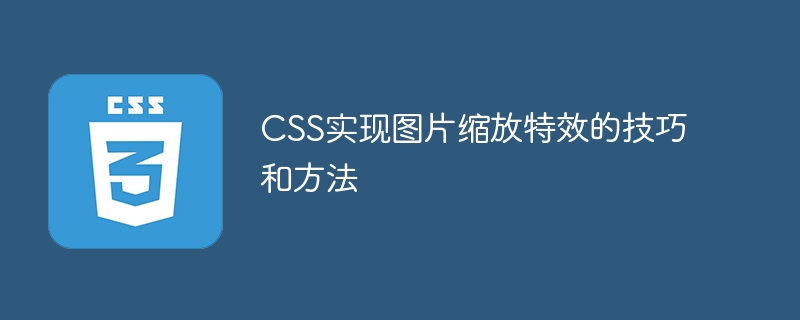

Techniques and methods for implementing image scaling effects using CSS require specific code examples
In web design, images are one of the indispensable elements. In order to make web pages more vivid and attractive, we often use special effects of zooming in and out of images to increase the visual effect. The following will introduce several common CSS techniques and methods, as well as specific code examples, to achieve image scaling effects.
The transform attribute is a powerful attribute in CSS3 that can be used to perform various transformation effects on elements, including scaling. Use the scale() function to achieve the zoom effect of the image. The specific code example is as follows:
.image {
transition: transform 0.3s;
}
.image:hover {
transform: scale(1.2);
}In the above code, a transition attribute is first added to the parent element of the image to specify the duration of the animation effect. Then, under the :hover pseudo-class selector, set the value of the transform attribute to scale(1.2), which means that the image will be enlarged to 1.2 times its original size. When the mouse is hovered over the image, the zoom effect is triggered.
In addition to using the transform attribute, you can also use the zoom attribute to achieve the zoom effect of the image. The zoom attribute is unique to IE, but is also supported in modern browsers. The specific code example is as follows:
.image {
transition: zoom 0.3s;
}
.image:hover {
zoom: 1.2;
}In the above code, the same transition attribute as before is used, and under the :hover pseudo-class selector, the value of the zoom attribute is set to 1.2, which means that the image is enlarged to 1.2 times the original. When the mouse is hovering over the image, the zoom effect is triggered.
In addition to using simple scaling effects, you can also use CSS animations to achieve more complex image scaling effects. By defining keyframes and animation properties, you can achieve more freedom and flexibility. The specific code example is as follows:
@keyframes scale {
0% {
transform: scale(1);
}
50% {
transform: scale(1.2);
}
100% {
transform: scale(1);
}
}
.image {
animation: scale 3s infinite;
}In the above code, the animation effect is defined through @keyframes key frames. In the 0% keyframe, set the zoom ratio of the image to 1, indicating the initial state. In the 50% keyframe, set the zoom ratio of the image to 1.2, which means it will be enlarged to 1.2 times the original size. In the 100% keyframe, set the zoom ratio of the image to 1, which means returning to the initial state.
Then, apply the defined animation attributes to the class selector of the picture, and set the value of the animation attribute to scale 3s infinite, which means using an animation named scale with a duration of 3 seconds and infinite Loop.
Summary:
By using the above CSS techniques and methods, we can easily achieve the zoom effect of images. From simple hover effects to complex animation effects, we can choose the appropriate method to achieve different effects according to our needs. By using the right code examples, we can make web pages more vivid and engaging, improving the user experience.
The above is the detailed content of Tips and methods for implementing image scaling effects with CSS. For more information, please follow other related articles on the PHP Chinese website!




